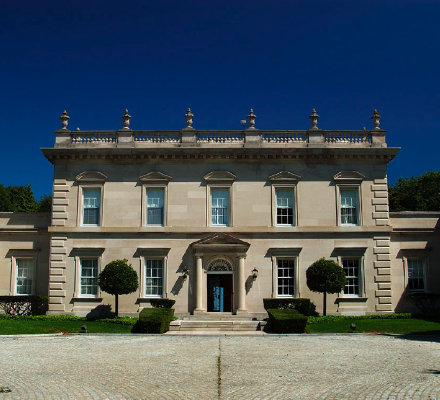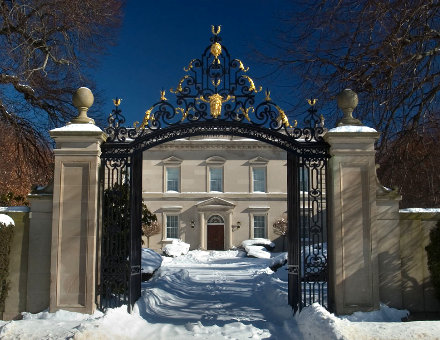London, GB | Formerly of New York, Buenos Aires, Fife, and the Western Cape. | Saoránach d’Éirinn.

About Andrew Cusack
 Writer, web designer, etc.; born in New York; educated in Argentina, Scotland, and South Africa; now based in London.
Writer, web designer, etc.; born in New York; educated in Argentina, Scotland, and South Africa; now based in London. read more
News
Blogs
Reviews & Periodicals
Arts & Design
World
France
Mitteleuropa
Knickerbockers
Argentina
The Levant
Africa
Cape of Good Hope
Netherlands
Scandinavia
Québec
India
Muscovy
Germany
Academica
Clarendon Court

CLARENDON COURT IS one of the more comely of the Newport “cottages”. Built a little later than most, it avoids the Mediterranean gallimaufry of the Breakers and the French frilliness of many of the other Newport mansions (The Elms, Marble House, etc.). Its chief fame, however, comes not from its architectural excellence but rather as the family home where Sunny von Bülow fell into a permanent vegetative state, leading to the arrest and conviction for attempted murder of her husband Claus von Bülow. Von Bülow’s conviction was overturned on appeal, when he was represented by the famous Alan Dershowitz.


Previously: Salve Regina University
Published at 8:12 pm on Sunday 21 October 2007. Categories: Architecture.
Search
Instagram: @andcusack
Click here for my Instagram photos.Most Recent Posts
- Sag Harbor Cinema March 26, 2025
- Teutonic Takeover March 10, 2025
- Katalin Bánffy-Jelen, R.I.P. March 3, 2025
- Substack Cusackiensis March 3, 2025
- In the Courts of the Lord February 13, 2025
Most Recent Comments
Book Wishlist
Monthly Archives
Categories
Home | About | Contact | Paginated Index | Twitter | Facebook | RSS/Atom Feed
andrewcusack.com | © Andrew Cusack 2004-present (Unless otherwise stated)



Excellent! And thanks for posting. Who was the architect?
The architecht I believe was Horace Trumbauer,who also built Miramar next door.Clarendon Court is a magnificent estate,the way it sits on the acreage and give the maximum vantage to the back yard and its just stunning.Can you imagine having this setup and letting greed for more ruin it and others lives permanantely!!!!
Trumbauer designed many French renaissance style villas in Newport and outside Philadelphia. His client list was a who’s who of New York and Philadelphia society. Berwind, Widener, Stotesbury, and Knight.
In Newport, he designed The Elms for Edward Berwind, Miramar for George Widener, Claradon Court (later named Clarendon) for Edward Knight, and the now vanished Chetwode for William Storrs Wells.
His more famous estates include the sadly demolished Whitemarsh Hall for Edward Stotesbury and the fastly dilapidating Lynnewood Hall for P.A.B. Widener outside Philedelphia.
Though Clarendon was never ocean front, the von Bulow’s acquired the adjacent Gull Rock estate in the 70s and had the house demolished… the lot was incorporated into the von Bulow estate.
Sunny’s parents, the Russell Aitken’s, lived across Bellevue Avenue in Champ Soleil, designed by Polhemus and Coffin in 1929. This was a fashionable and still strictly residential district along Bellevue Avenue, away from the tourists visiting the mansions of the Gilded Age and away from the many condos the enveloped other notable mansions.
Trumbauer also designed “Rose Terrace,” the Dodge estate in Grosse Pointe Farms, Michigan, around 1930 – dubbed by someone (sorry I can’t recall) “the last great house built in America.” Mrs. Dodge was asked to allow its use as the location for “The Great Gatsby,” but refused. Sadly, it was demolished in the late 1970’s. Some photographs of it can be viewed if one Googles “Homes of the Auto Barons” or the Grosse Pointe Historical Society. Fortunately, the Edsel & Eleanor Ford house up Lake Shore Road survives, as does Meadowbrook Hall (the other Dodge estate, in suburban Rochester), both of which are open to the public as house-museums.